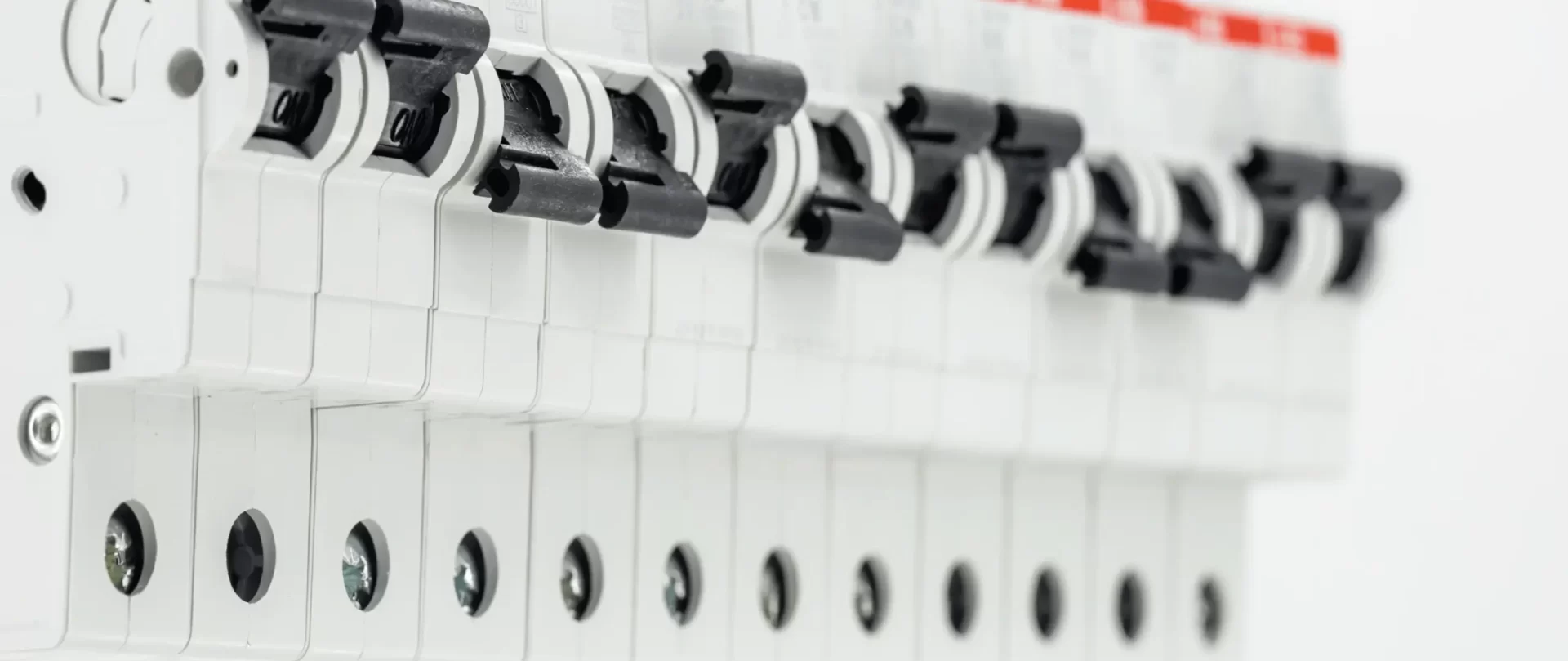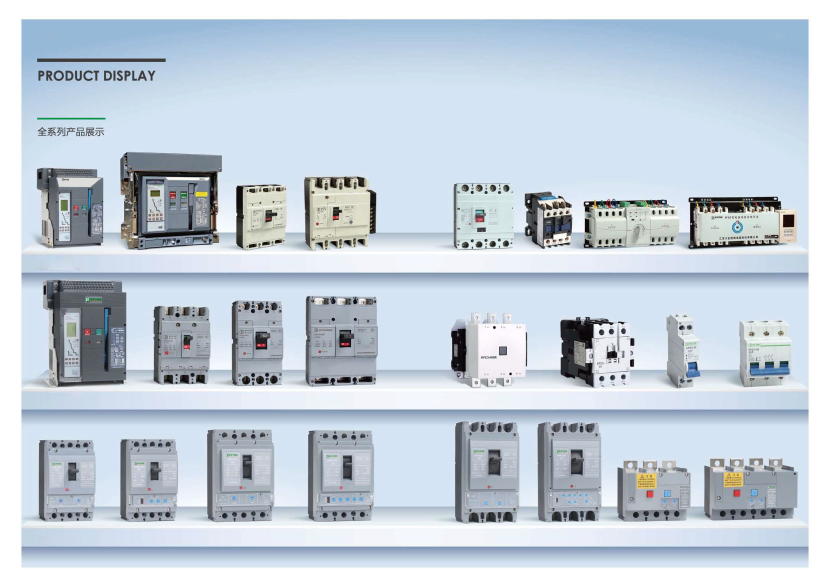Classification of circuit breakers
– Frame Circuit Breakers (ACB)
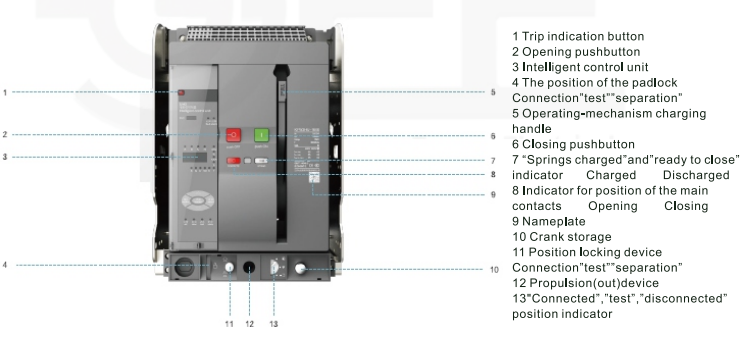
Frame circuit breaker is also known as universal circuit breaker, all its parts are installed in an insulated metal frame, often open type, can be equipped with a variety of accessories, replacement of contacts and parts is more convenient, mostly used in the power end of the main switch. The overcurrent disconnectors are electromagnetic, electronic and intelligent disconnectors and so on. Circuit breakers have long delay, short delay, instantaneous and ground fault protection, each protection setting value is based on its shell frame level within a certain range of adjustment.
The frame circuit breaker is suitable for AC 50Hz, rated voltage 380V, 660V, rated current 200A-6300A in the power distribution network, mainly used to distribute power and protect the line and power equipment from overload, undervoltage, short-circuit, single-phase grounding faults and other hazards, the circuit breaker has a variety of intelligent protection functions, can be done to selective protection. (Click to follow ☞ Building 10 technical public number) Under normal conditions, it can be used as the infrequent conversion of the line. 1250A or less circuit breaker can be used as the protection of motor overload and short-circuit in the network of AC 50Hz voltage 380V.
Frame circuit breakers are also frequently used in 400V side outlet main switches of transformers, bus contact switches, large-capacity feeder switches and large motor control switches.
-Moulded Case Circuit Breakers (MCCB)
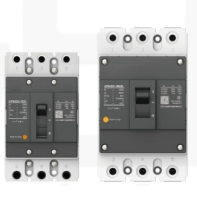
Moulded Case Circuit Breakers, also known as Device Circuit Breakers, have earth wire terminal external contacts, interrupting chambers, striker and operating mechanism housed in a plastic enclosure. Auxiliary contacts, undervoltage striker as well as shunt striker etc. are mostly modular, very compact, generally not considered for maintenance, and are suitable for use as protection switches for branch circuits.
Moulded case circuit breakers usually contain a thermo-magnetic trip unit, while larger models are equipped with a solid-state trip sensor. Moulded case circuit breaker overcurrent tripper has electromagnetic and electronic two kinds, general electromagnetic moulded case circuit breaker for non-selective circuit breaker, only long delay and instantaneous two kinds of protection mode; Electronic moulded case circuit breaker has long delay, short delay, instantaneous and ground fault four kinds of protection function. Part of the electronic moulded case circuit breaker newly launched products with regional selective chain function.
Moulded case circuit breakers are generally used for distribution feeder control and protection, small distribution transformer low voltage side of the main switch, power distribution terminal control, can also be used for a variety of production machinery power switch.
-Micro Circuit Breaker (MCB)
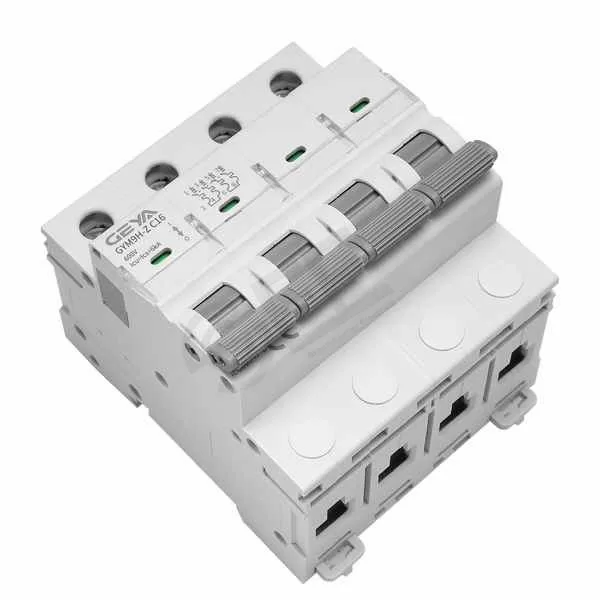
Miniature Circuit Breaker (MCB) is one of the most widely used terminal protection appliances in building electrical terminal distribution devices. It is used for single-phase and three-phase short-circuit, overload and over-voltage protection below 125A, including single-pole 1P, two-pole 2P, three-pole 3P and four-pole 4P.
Miniature circuit breaker consists of operating mechanism, contacts, protection devices (various disconnectors), arc extinguishing system and so on. Its main contacts are operated manually or closed by electric power. After the main contact is closed, the free release mechanism locks the main contact in the closed position. The coil of the overcurrent striker and the thermal element of the thermal striker are connected in series with the main circuit, and the coil of the undervoltage striker is connected in parallel with the power supply.
In the electrical design of civil buildings, miniature circuit breakers are mainly used for overload, short circuit, overcurrent, loss of voltage, undervoltage, grounding, leakage, automatic switching of dual power sources and infrequent starting of electric motors for protection, operation and other purposes.
Basic characteristic parameters of circuit breaker
– (1) Rated operating voltage Ue
Rated working voltage refers to the nominal voltage of the circuit breaker, which is capable of continuous operation under the specified normal use and performance conditions.
Our country stipulates that in 220kV and the following voltage levels, 1.15 times of the rated voltage of the system is the highest working voltage; 330kV and above voltage levels are 1.1 times of the rated voltage as the highest working voltage. The circuit breaker can keep insulation under the highest working voltage of the system, and can close and open according to the specified conditions.
– (2) Rated current In
Rated current refers to the current that can be passed by the circuit breaker for a long period of time at an ambient temperature of 40℃ or below. For the circuit breaker with adjustable release, it is the maximum current that the release can pass for a long time.
When used in the ambient temperature exceeds 40 ℃, but not higher than 60 ℃, it is allowed to reduce the load long-term work.
– (3) Overload tripper current setting value Ir
When the current exceeds the tripper current setting value Ir, the circuit breaker trips with delay. It also represents the maximum current that the circuit breaker can withstand without tripping. This value must be greater than the maximum load current Ib, but less than the maximum current Iz allowed on the line.
The thermal take-off relay, Ir, is normally adjustable from 0.7 to 1.0 In, but if electronic equipment is used, the range of adjustment is greater, usually 0.4 to 1.0 In. For circuit breakers equipped with non-adjustable overcurrent take-off relays, Ir = In.
– (4) Short-circuit take-off relay current setting value Im
The short-circuit take-off relay (instantaneous or short delay) is used to trip the circuit-breaker quickly when a high fault current value occurs, and its tripping threshold value is Im.
– (5) Rated short-time withstand current Icw
It refers to the value of current allowed to pass within an agreed period of time. This current value passes through the conductor within the agreed time without causing damage to the conductor due to overheating.
– (6) Breaking capacity
Breaking capacity of the circuit breaker refers to the ability of the circuit breaker to safely cut off the fault current, and its rated current is not necessarily related to the former 36KA, 50KA and other specifications. Generally divided into limit short-circuit breaking capacity Icu and operating short-circuit breaking capacity Ics.
General principles of circuit breaker selection
Firstly, select the type and number of poles of the circuit breaker according to the purpose; select the rated current of the circuit breaker according to the maximum working current; select the type of disconnector, type and specification of accessories according to the need. The specific requirements are as follows.
(1) The rated working voltage of the circuit breaker is ≥ the rated voltage of the line.
2)Rated short-circuit interrupting capacity of the circuit breaker ≥ the calculated load current of the line.
(3) The rated short-circuit breaking capacity of the circuit breaker ≥ the maximum short-circuit current that may occur in the line (generally calculated on the basis of RMS value).
(4) line end single-phase ground short-circuit current ≥ 1.25 times the circuit breaker instantaneous (or short delay) release setting current .
(5) The rated voltage of circuit breaker under-voltage release is equal to the rated voltage of the line.
(6) The rated voltage of the circuit breaker’s shunt release is equal to the voltage of the control power supply.
(7) The rated operating voltage of the electric drive mechanism is equal to the control supply voltage.
(8) When the circuit breaker is used for lighting circuit, the instantaneous rectification current of the electromagnetic disconnector is generally taken as 6 times of the load current.
(9) When the circuit breaker is adopted as the short-circuit protection of single motor, the instantaneous setting current of the tripper is 1.35 times (DW series circuit breaker) or 1.7 times (DZ series circuit breaker) of the starting current of the motor.
(10) When the circuit breaker is used as short-circuit protection for several motors, the setting current of the instantaneous tripper is 1.3 times of the starting current of the largest motor plus the working current of the remaining motors.
(11) When the circuit breaker is used as the main switch on the low-voltage side of the distribution transformer, its breaking capacity should be greater than the short-circuit current on the low-voltage side of the transformer, the rated current of the tripper should not be less than the rated current of the transformer, and the rectifying current of the short-circuit protection is generally 6-10 times of the rated current of the transformer; and the rectifying current of the overload protection is equal to the rated current of the transformer.
(12) After the initial selection of circuit breaker type and level, but also with the upper and lower switch protection characteristics to match, so as not to overstep the trip, expanding the scope of the accident.
Selectivity of circuit breakers
Circuit breakers used in the power distribution system can be divided into two categories, selective and non-selective, according to their protection performance. Selective low-voltage circuit breaker, there are two protection and three protection two. Among them, instantaneous characteristics and short delay characteristics are suitable for short-circuit action, while long delay characteristics are suitable for overload protection. Non-selective circuit breaker, generally instantaneous action, only for short-circuit protection. There are also long delay action, only for overload protection. In the power distribution system, if the upper level circuit breaker adopts selective circuit breaker, the next level circuit breaker adopts non-selective circuit breaker or selective circuit breaker, mainly using the delayed action of the short-delay tripper or the difference in the time of the delayed action, in order to obtain selectivity. When passing through the delayed action of the next level circuit breaker, please note the following points.
(1) Regardless of whether the next level is a selective or non-selective circuit breaker, the instantaneous overcurrent tripper setting current of the upper level circuit breaker shall generally not be less than 1.1 times the maximum three-phase short-circuit current at the outlet end of the next level circuit breaker.
(2) If the next level is a non-selective circuit breaker, in order to prevent short-circuit current occurring in the circuit protected by the next level circuit breaker, due to insufficient sensitivity of the instantaneous action of this level, the short-delay overcurrent tripper of the previous level will be acted firstly, so as to make it lose selectivity. Generally, the setting current of the short delay overcurrent tripper of the upper level circuit breaker is not less than 1.2 times of the instantaneous overcurrent tripper of the next level.
(3) If the next level is also selective circuit breaker, in order to ensure selectivity, the short delay action time of the upper level circuit breaker is at least 0.1s longer than that of the next level circuit breaker. generally speaking, to ensure selective action between the upper and lower two levels of low-voltage circuit breakers, it is appropriate to select the overcurrent tripter with short delay for the upper level circuit breaker, and its action current should be greater than that of the next level overcurrent tripter action current. At least the action current Iop.1 of the upper level is not less than 1.2 times of the action current Iop.2 of the next level, i.e. Iop1≥1.2Iop.2.
Cascade protection of circuit breakers
In the design of the power distribution system, the selective cooperation between the upper and lower levels of the circuit breaker must have “selectivity, rapidity and sensitivity”.
Selectivity is related to the upper and lower two levels of cooperation between the circuit breaker, while the rapidity and sensitivity are related to the characteristics of the protection appliance itself and the line operation mode.
The upper and lower two levels of circuit breakers with proper coordination, can selectively remove the fault circuit, to ensure that the other fault-free circuit of the distribution system continues to work normally. On the contrary, it affects the reliability of the distribution system.
Cascade protection is a specific application of circuit breaker current-limiting characteristics, the main principle is to use the upper level of the current-limiting circuit breaker, in the selection of the lower level of the circuit breaker, you can choose the circuit breaker with lower breaking capacity, in order to achieve the purpose of reducing costs and saving money. The upper level of current-limiting circuit breaker QF1 can break the maximum expected short-circuit current at its installation, due to the distribution system of the upper and lower levels of the circuit breaker for the series installation, when the lower level, the circuit breaker QF2 outlet short-circuit, the short-circuit current due to the upper level of the current-limiting effect of the circuit breaker QF1 to make the actual value of the short-circuit current is much smaller than the expected short-circuit current at that location, that is to say, the lower level of the breaking capacity of the circuit breaker QF2 in the upper level of the That is to say, the breaking capacity of the lower level circuit breaker QF2 is greatly enhanced with the help of the upper level circuit breaker QF1 and exceeds its rated breaking capacity. This cascade protection also has certain conditions, such as the neighbouring circuits can not have important loads (because once QF1 trip QF3 circuit is also blackout), and at the same time the QF1 transient setting value and QF2 transient setting value should be matched appropriately. Cascade data can only be determined by experiments, the upper and lower levels of the circuit breaker with the choice can only be provided by the circuit breaker manufacturer to determine.
Sensitivity of circuit breakers
In order to ensure that the circuit breaker’s instantaneous or short delay overcurrent tripper can be reliably operated when the slightest short-circuit fault occurs within its protection range under the minimum operation mode of the system, the sensitivity of the circuit breaker protection must meet the requirements of “Low Voltage Distribution Design Code” (CB50054-95). The sensitivity of the circuit breaker protection must meet the “low-voltage power distribution design code” (CB50054-95) provides that its sensitivity should not be less than 1.3, that is, Sp = lk.min/Iop ≥ 1.3. where lop is the instantaneous or short-delay overcurrent tripper action current, Ik.Min is the circuit breaker protection of the end of the line in the system’s minimum mode of operation of a single-phase short circuit current or two-phase short circuit current, Sp is the circuit breaker action current, and the circuit breaker protection is the minimum mode of operation, and the circuit breaker protection is the minimum mode of operation, and the circuit breaker protection is the minimum mode of operation. Min is the single-phase short-circuit current or two-phase short-circuit current of the end of the line protected by the circuit breaker under the minimum operation mode of the system, and Sp is the sensitivity of the circuit breaker.
In the selection of circuit breakers, attention should also be paid to the sensitivity of the calibration, for both short delay and instantaneous overcurrent detent selective circuit breaker, only need to calibrate the short delay overcurrent detent action sensitivity, do not need to calibrate the instantaneous overcurrent detent action sensitivity.
Selection and setting of circuit breaker disconnectors
(1) Instantaneous overcurrent tripper action current adjustment
The object protected by the circuit breaker has certain electrical equipments, which will produce a high peak current several times of its rated current in a short time during the start-up process, thus making the circuit breaker withstand a large spike current in a short time. The action current lop(o) of the instantaneous overcurrent tripper must escape the line spike current Ipk, i.e. Iop(o) ≥ Krel-Ipk. where Krel is the reliability factor. In the selection of circuit breakers, attention should be paid to make the circuit breaker’s instantaneous overcurrent detector of the rectification current to avoid the spike current, so as not to cause the circuit breaker’s false operation.
(2) short delay overcurrent tripper action current and action time setting
Short delay time overcurrent tripper action current lop (s), should also avoid the line spike current Ipk, that is, Iop (s) ≥ Krel – Ipk. where, Krel for the reliability factor. Short delay time overcurrent tripper action time is generally divided into 0.2s, 0.4s and 0.6s three kinds, according to the front and rear of the protection device to determine the protection selectivity, should be made before the first level of protection of the action time than the action time of the latter level of protection is longer than the action time of a time level difference.
(3) Long delay time overcurrent tripper action current and action time adjustment
Long delay time overcurrent tripper is mainly used to protect the overload, so its action current Iop (l) only need to avoid the line’s maximum load current that is calculated current I30, i.e., Iop (l) ≥ Krel – I30. where, Krel is the reliability factor. The action time of the long delay overcurrent trip detector should dodge the duration of the permissible short-time overload, so as not to cause false operation of the low-voltage circuit breaker.
(4) overcurrent tripper action current and the line to be protected with the requirements of coordination
In order not to line due to overload or short-circuit caused by insulation cable overheating damage or even fire, and its circuit breaker does not trip the accident occurs, the circuit breaker overcurrent tripper action current lop should be in line with the requirements of the formula, lop ≤ Kol – Ial. where Ial for the permissible insulated cable flow; Kol for the permissible short-term overload coefficient of the insulated cable for the instantaneous and short-delay overcurrent detent, generally take 4.5; Kol for the permissible short-time overload factor of insulated cable for the short delay overcurrent detent. For instantaneous and short-delay overcurrent tripper, generally take 4.5; for long-delay overcurrent tripper, take 1.1 for short-circuit protection, and take 1 for overload protection only; if the above requirements are not met, the action current of the tripper should be changed, or the cross-sectional area of the conductor or cable is appropriately thickened.

